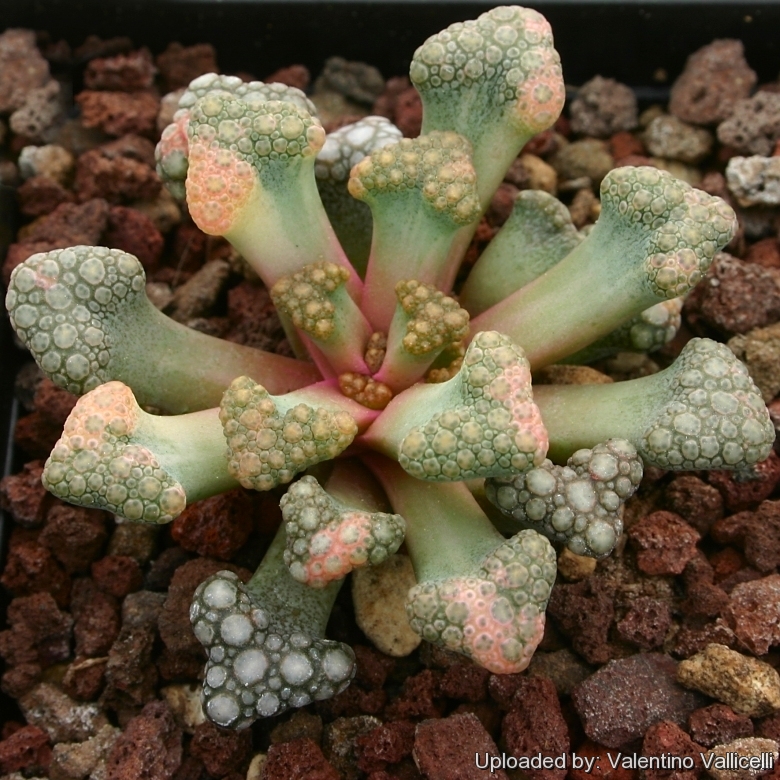
Titanopsis hugo-schlechteri f. variegata Photo by: Valentino Vallicelli
Origin and Habitat: Garden origin (Nursery produced cultivar)
Synonyms:
See all synonyms of Titanopsis hugo-schlechteri
Description: Titanopsis hugo-schlechteriSN|13465]]SN|13465]] is a multi-headed rosette succulent plant, it will form small mats as it ages. Individual rosettes are approx 4-5 cm in diameter.
Variegated forms: Variegated T. hugo-schlechteri are seldom seen and priced in cultivation. All variegates are mutants. Something has gone wrong with the cellular structure of the growth tip (apical meristem) of the plant. As a result of this mutation, chlorophyll is missing from some or all layers of the plant epidermis. The odd variegate appears in many seedling batches in a small percentage, and is generally separated from normal plants. Variegated plants grow more slowly, and are generally smaller than non-variegates of the same species. Coloured areas are also generally weaker, and more susceptible to fungus, sunburn and other defects. These are harder to grow well than they appear.
Stem: Stem-less or very short-stemmed.
Root: Fleshy taproots.
Leaves: Approx 2 cm long, crowded, with sculptured triangular/spatulate tips covered with pebbly flattish bumps. The colour of the leaves is very variable, depending on environmental and individual factors and comprises pale an dark green, blue, grey, red and purple while the wart vary from white to reddish-brown. The variegated parts are paler pink or yellowish.
Flowers: Small daisy-like, yellow to orangish (occasionally pink) they last for several days and the colour varies as they ages taking a darker tone.
Blooming season: Winter.
Subspecies, varieties, forms and cultivars of plants belonging to the Titanopsis hugo-schlechteri group
Bibliography: Major references and further lectures
1) Heidrun E. K. Hartmann “Aizoaceae F – Z” Springer, 2002
2) James Cullen, Sabina G. Knees, H. Suzanne Cubey “The European Garden Flora Flowering Plants: A Manual for the Identification of Plants Cultivated in Europe, Both Out-of-Doors and Under Glass - Casuarinaceae to Aristolochiaceae” Cambridge University Press, 11/ago/2011
3) Hermann Jacobsen, Vera Higgins “Succulent Plants: Description, Cultivation and Uses of Succulent Plants, Other Than Cacti” Williams and Norgate, Limited, 1935
4) Jacobsen. “Handbook of succulent plants” 1328 (1960)
5) H. Herre “The genera of the Mesembryanthemaceae”Tafelberg-Uitgewers Beperk, 1971
Cultivation and Propagation: This species is easy to grow and clumps readily, forming a beautiful succulent mat. Needs moderate water when growing in late fall and early spring. Keep somewhat dry the rest of the time. Like all living rocks, they thrive in porous soils with excellent drainage. It can tolerates high heat and heavy frost (hardy to -10° C). It is a very rewarding succulent, and can be cultivated in desert gardens in warm climates or in greenhouses or windowsills in the home. Enjoys bright shade in summer and full sun in the other seasons.
Special cares for variegated forms: In the summer it is best to avoid direct sun during the hottest hours of the day (but they benefits from morning sun, that helps to produce strong and colourful spines). In case of cultivation in full sun it is best to plant with the variegated spot facing northeast, so it gets the least amount of direct sunlight as possible.
Propagation: By division of larger clumps.










